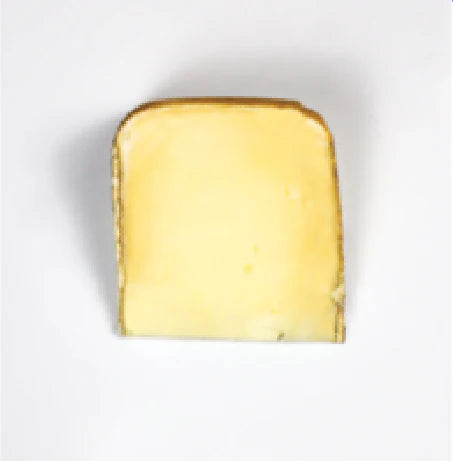ANABASQUE
Producer: Landmark Creamer

LOCATION & HISTORY
In Wisconsin, a state known for its enduring European-inspired cheesemaking, Landmark Creamery pays homage to the time-honored tradition of Ossau Iraty production with Anabasque — aptly named for both its inspiration and modern creator. The milk for their flagship cheese comes from a single farm located 20 minutes away from the creamery. This woman-run sheep dairy is unique and known for their high quality and high-yield milk that produces an exceptionally clean flavor in the cheese. The milk comes from a hybrid breed called Assaf, which is frequently used in Spanish and Portuguese cheesemaking. Because the milk is transported only a short distance and handled minimally, the milk has a cleaner flavor and aroma with very little of the piquant and slightly soapy lipase flavor that is so prominent in many industrially produced sheep’s milk cheeses.
MAKE DESCRIPTION
Anabasque is made once a week in an open vat by head cheesemaker Anna Landmark. After the milk is pasteurized and coagulated with traditional animal rennet, the curds are cut and gently cooked before being drained and gently hand-scooped into their molds. Cooking at a low temperature prevents too much whey from being expelled at this stage, and helps maintain appropriate pH levels in the vat. While the wheels are cooling in the molds, they are pressed, flipped, and pressed again — a technique that helps the curds fuse together to form a smooth texture, as well as expels whey. When the wheels can hold their form, they are dry salted in a unique process borne out of necessity, as Landmark Creamery’s facility is too small for a brine tank — the wheels are placed into a bag with salt for 2–3 days, during which time it is flipped to evenly distribute the salt. Dry salting in this way helps develop the rind, as well as controls bacterial activity within the cheese that contributes to flavor. After salting, the wheels are ready for the aging room, where they are aged on wooden boards. Over the course of 4–9 months, the rinds are washed periodically with salt water and cultures to help develop its signature peachy hue and slight funk as a result of the culture b.linens. The wheels are tasted beginning at 3 months to determine when the flavor is at its best - because affinage is a nuanced process dependent on many environmental factors including temperature, humidity, and seasons, the human element of tasting and intuition is incredibly important to ensure that the cheese is released for sale in peak condition.
PRODUCER HISTORY
Landmark Creamery was founded in 2013 in Paoli, Wisconsin by Anna Landmark and Anna Thomas Bates. They knew they had access to some of the best quality milk in the state and dreamed of using that milk to create excellent sheep’s milk cheeses. Anabasque was their very first cheese and is now their best selling product nationally, accounting for 40% of their annual cheese production — and that number is only increasing as the creamery grows. Anabasque took 1st place in its category at the 2023 American Cheese Society Judging & Competition!
In addition to their sheep’s milk cheeses, Landmark Creamery also produces a line of stellar cow’s milk cheeses and a few styles of decadent small-batch butter. In order to guarantee the highest quality milk, they work with nearby farmers to build sustainable, family-run dairies that also help support the local economy in Southern Wisconsin.
TASTING NOTES
This semi-hard cheese boasts a fudgy bite and a creamy mouthfeel. With a whisper of funk and hint of lanolin, Anabasque is an approachable but interesting cheese that tastes of salted cultured butter, stone fruit, citrus, and toasted almonds. Younger wheels of Anabasque melt beautifully into any dish, and older wheels can be grated over salads, pasta, and more.




